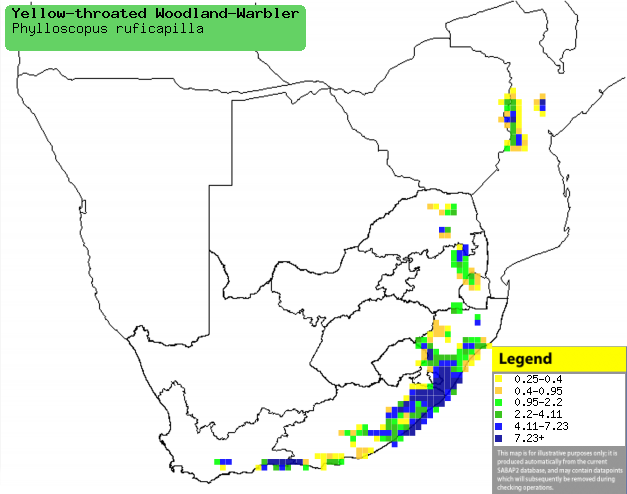|
Phylloscopus ruficapilla
(Yellow-throated woodland-warbler, Yellow-throated warbler)
[= Seicercus ruficapillus]
Geelkeelsanger [Afrikaans]; Umbese, Unoqandilana [Xhosa];
Pouillot à gorge jaune [French]; Rotkopf-laubsänger [German];
Felosa-de-peito-amarelo [Portuguese]
Life
> Eukaryotes >
Opisthokonta
> Metazoa (animals) >
Bilateria >
Deuterostomia > Chordata >
Craniata > Vertebrata (vertebrates) > Gnathostomata (jawed
vertebrates) > Teleostomi (teleost fish) > Osteichthyes (bony fish) > Class:
Sarcopterygii (lobe-finned
fish) > Stegocephalia (terrestrial
vertebrates) > Tetrapoda
(four-legged vertebrates) > Reptiliomorpha > Amniota >
Reptilia (reptiles) >
Romeriida > Diapsida > Archosauromorpha > Archosauria >
Dinosauria
(dinosaurs) > Saurischia > Theropoda (bipedal predatory dinosaurs) >
Coelurosauria > Maniraptora > Aves
(birds) > Order: Passeriformes
> Family: Sylviidae > Genus: Phylloscopus
Distribution and habitat
Occurs from Tanzania through north-eastern Mozambique to
southern Africa. Here it is locally common in lowland evergeen and Afromontane
forest, generally staying the mid to upper canopy.
|
 |
|
Distribution of Yellow-throated woodland warbler in southern Africa,
based on statistical smoothing of the records from first SA Bird Atlas
Project (©
Animal Demography unit, University of
Cape Town; smoothing by Birgit Erni and Francesca Little). Colours range
from dark blue (most common) through to yellow (least common).
See here for the latest distribution
from the SABAP2. |
Food
It mainly eats arthropods, gleaning them from leaves and
branches in the tree canopy and often joining mixed species foraging flocks. The following food items have been recorded
in its diet:
Breeding
- The nest is a domed cup built almost entirely out of green moss, lined
with fine grass and feathers. It is typically placed on a moss-covered bank,
often next a stream and surrounded by bushes or ferns.
- Egg-laying season is from about October-December.
- It lays 2-3 eggs, which are incubated for roughly 17 days.
- The chicks stay in the nest for about 16 days.
Threats
Not threatened.
References
-
Hockey PAR, Dean WRJ and Ryan PG 2005. Roberts
- Birds of southern Africa, VIIth ed. The Trustees of the John Voelcker
Bird Book Fund, Cape Town.
-
Harrison, J.A., Allan, D.G., Underhill, L.G., Herremans, M.,
Tree. A.J., Parker, V. & Brown, C.J. (eds). 1997. The atlas of southern
African birds. Vol. 2: Passerines. BirdLife South Africa, Johannesburg.
|
